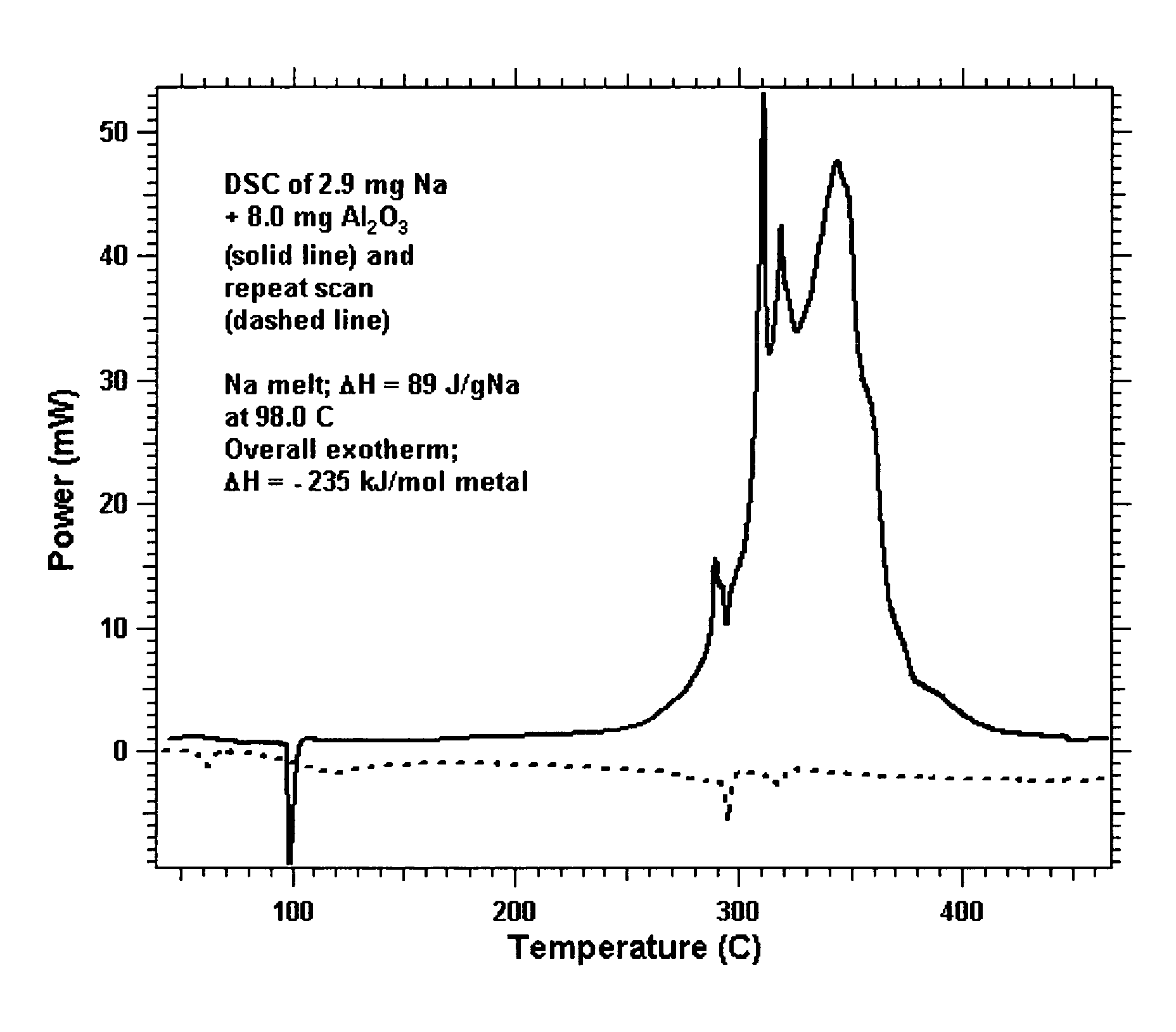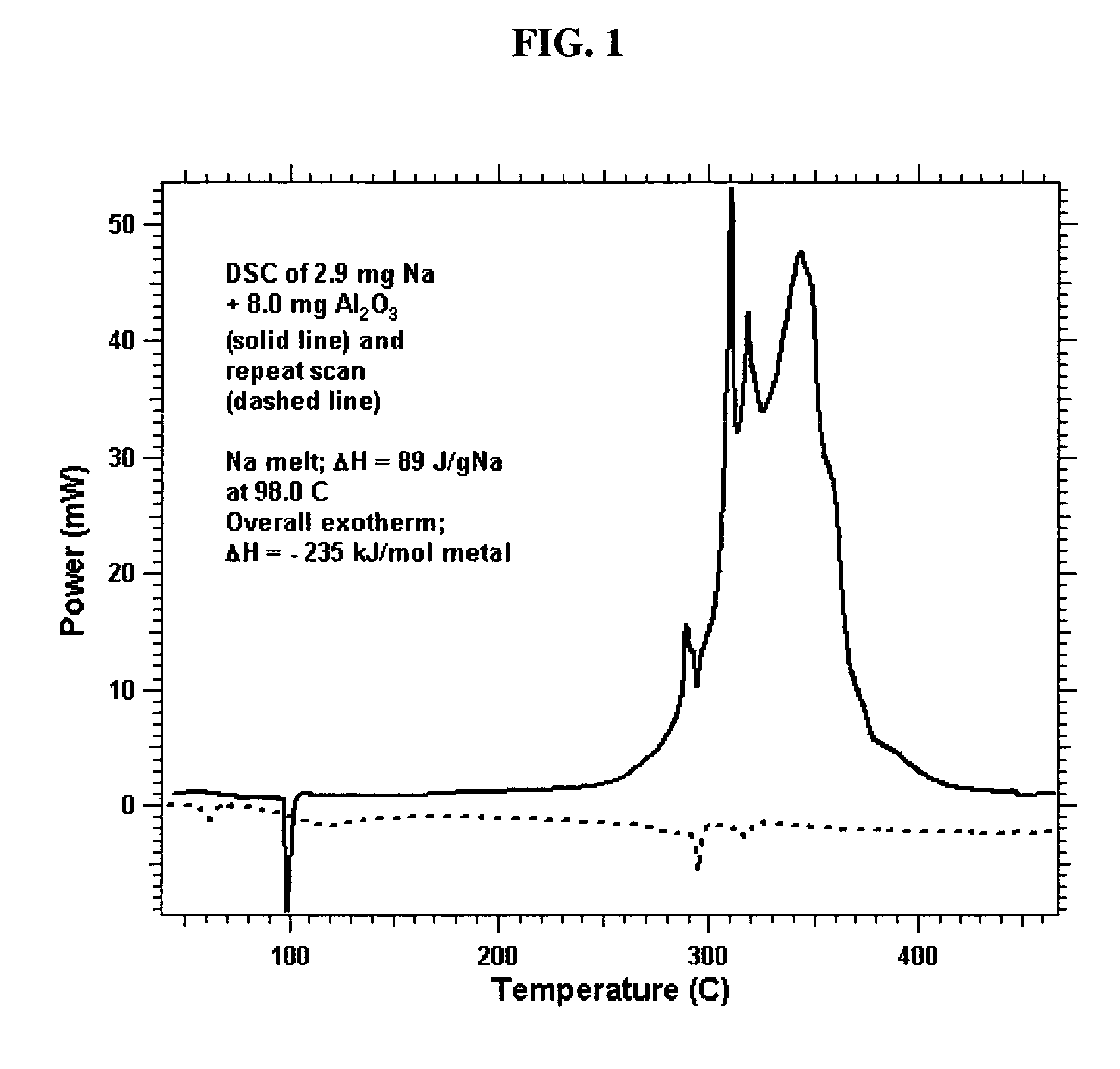Titanium oxide and alumina alkali metal compositions
a technology of alumina alkali metal and composition, applied in the field of porous metal oxide composition, can solve the problems of high sodium absorbed by the zeolite composition, spontaneous fire of alkali metals and their alloys, and severe restrictions on its shipment and us
- Summary
- Abstract
- Description
- Claims
- Application Information
AI Technical Summary
Benefits of technology
Problems solved by technology
Method used
Image
Examples
example 1
[0074]Exemplary porous metal oxides. Porous TiO2 (Anatase) from Sachtleben Chemie, (29.5 nm diameter pores, or 295 Å) and activated porous alumina (358 m2 / g) from Almatis AC were calcined in air at 600° C. and then cooled to room temperature. To these powders in a helium-filled glove box was added liquid Na2K dropwise onto the porous oxide in a stainless steel tray. The liquid alloy was quickly absorbed into the porous metal oxides. As long as the overall concentration of metal did not exceed 30 wt %, the white powder turned to dark black in color and the mixture became a uniform loose powder. This provided samples of Stage 0 material, as shown in FIG. 5.
example 2
[0075]One significant feature of the Group 1 metal / porous metal oxide compositions of the invention is their ability to produce pure hydrogen gas upon addition to water. The “reducing power” of the Group 1 metal / porous metal oxide compositions was determined by adding water to an evacuated sample and collecting hydrogen with a modified Toeppler pump. The reducing power is defined as the weight percent of alkali metal or alloy used that would produce the same amount of hydrogen. This was verified by collecting the hydrogen produced from a known mass of material upon reaction with out-gassed water. The hydrogen was collected in a calibrated pipette using a modified Toeppler pump (mercury filled). Such analyses were run on every sample of reduced porous metal oxide, regardless of the stage of the material. For example, if a 30 wt % sample of NaK in Stage I porous metal oxide produced the same amount of hydrogen as would be produced by that amount of NaK alone, the reducing power would ...
example 3
[0076]The preparation of Stage I material can be performed by continuous heating of Stage 0 materials to 150° C. or by using the higher melting alkali metals, such as sodium and potassium. Outgassed and calcined porous alumina 14.0 g, was weighed out and, together with 6.0 g of Na metal, was introduced into a Parr Stainless steel reactor equipped with a Teflon gasket seal. The combination of porous metal oxide and Na was heated while rotating the reactor end-over-end at 60 rpm, first to 105° C. for 1 hr, then overnight at 155° C. The powder was loose, black and free flowing. Similar processes to convert Stage 0 Na2K—Al2O3, Na2K—TiO2 and Na—TiO2 to Stage I materials were also carried out. For example, a DSC of 21 wt % material is shown in FIG. 6.
PUM
| Property | Measurement | Unit |
|---|---|---|
| temperature | aaaaa | aaaaa |
| melting point | aaaaa | aaaaa |
| melting point | aaaaa | aaaaa |
Abstract
Description
Claims
Application Information
 Login to View More
Login to View More - R&D
- Intellectual Property
- Life Sciences
- Materials
- Tech Scout
- Unparalleled Data Quality
- Higher Quality Content
- 60% Fewer Hallucinations
Browse by: Latest US Patents, China's latest patents, Technical Efficacy Thesaurus, Application Domain, Technology Topic, Popular Technical Reports.
© 2025 PatSnap. All rights reserved.Legal|Privacy policy|Modern Slavery Act Transparency Statement|Sitemap|About US| Contact US: help@patsnap.com



